A Brief History of the Foothill Fibers Guild
According to founding member Dee Jones, two events sparked the formation of the Foothill Fibers Guild: a class and a sale. The class was a nuts-and-bolts weaving workshop taught by Harold Dickey. Shortly afterward, a few fiber artists decided to have a show and sale, and invited all local weavers and spinners to participate. The sale was a gala affair at one of Grass Valley’s historic residences, the sprawling home of the (in)famous dancer Lola Montez. “We filled all three rooms of the Lola Montez home,” Dee recalls. A member of the Sacramento Guild, Frances Taylor, trekked up Hwy 49 to judge the show. With admiration and a touch of wistfulness, Dee remembers her dedication and generosity: “She arrived at 8 AM and she didn’t leave until 6 PM, and she wouldn’t take a penny for her work.”
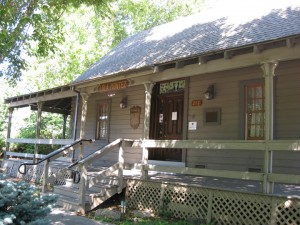
Lola Montez Home, 248 Mill Street, Grass Valley. The fiber show and sale here in March 1980 was a catalyst for the formation of the Guild.
The sale was held in March of 1980, and on April 10 a few trail blazers met at the Posh Nosh Deli in Nevada City to discuss how to organize a guild. A newsletter was seen as a needful form of communication, and dues were set at $12/year.
Pointing to some embroidery miniatures on her wall, Dee explained the reason for the name Foothill Fibers. “We had one very talented embroideress named Katherine Colwell. Katherine was a silk screener too, and she designed the logo for us and silkscreened our first bags. We were primarily weavers and spinners. Everyone was a knitter, but that was a given. We wanted to call ourselves the Foothill Weavers and Spinners, but Katherine really wanted to be in the guild, and she asked if it could be called a fibers guild instead. In the end, calling it a fibers guild served us well; it might have gone under if we had restricted ourselves to weaving and spinning. As it is, we have a lot of other fiber workers.”
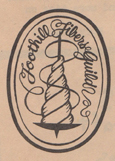
Original Logo October 1980 designed by Katherine Colwell
Dee continues describing the early days. “We were offered a space by a weaver named Irma Winter. She had a Victorian home on Zion Street, and the whole downstairs was her “loom room.” It was completely devoted to weaving. Irma welcomed us, and that is where we met [except for special occasions]. We also had dye classes there, and workshops. She was very hospitable .” The first official Foothill Fibers Guild meeting was held on the afternoon of July 8, 1980, at Irma’s home. A weaver with 40 years experience, Irma offered the first program of a “Show and Tell” of her work, her looms, and a variety of weaving techniques. There were 16 members on the roster. By September, there were 36.
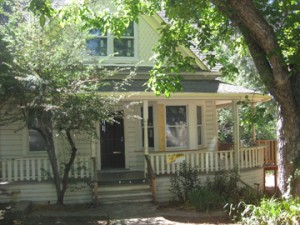
Irma Winter’s home at 436 Zion Street, Nevada City was the original meeting location for the Foothill Fibers Guild.
Volunteers had come forward as midwives to help birth the new guild. Mary Tendall, mother of two young children and owner of 20+ angora goats, served as the first president. “She did wild stuff,” charter member Sue Vogt recalls. “She was a true artist, always after us for being too safe.” Dee Jones, an enthusiastic weaver who got a lot of handwork done during her summers as a fire lookout in Mt. Lassen National Forest, offered to serve as treasurer. Lindsey Cleveland, a teacher of fiber arts at the Quaker-run Woolman High School, volunteered to be secretary. “We were pretty loosey-goosey in those days,” says Lindsey. “A group of ex-hippies trying to form an organization.” Katherine Colwell stepped up as the guild historian, and her book reviews graced the pages of the newsletter. Ann Austin and Arline Tedeschi offered to prepare programs. Renee Chevreaux helped organize the first study group for “spinning and natural dye enthusiasts,” and, under the title of “Roving Reporter,” she interviewed members for the newsletter. Within a few months, Sue Vogt became the editor of the guild newsletter, which was the primary organ of communication in the days before internet.
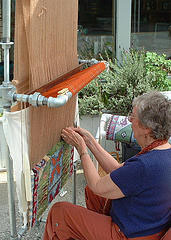
The Guild’s 2005 collaborative Knotted Pile Rug was funded by a FiberHearts award from Interweave Press. Members raised the animals, spun the fleece, dyed the yarn, wove the foundation, and tied the knots. (Pictured here, Dee Jones.)
It appears that the new guild had a lot of young mothers. Sue Vogt’s son is the same age as the Foothill Fibers: 35 years old. He recently told his mom that one of his most vivid childhood memories is the constant clanking of the loom. One workshop materials list includes “yarn of various sizes, needles of various sizes, and snacks if you are pregnant.” One book reviewed in the newsletter is The Creative Woman’s Getting-It-All-Together at Home Handbook, with a chapter noted as specially relevant: “Playpen in the Studio.”
Another feature of the guild, which remains true today, was that many members lived on farms or out in the country. Perhaps this is a legacy of the “ex-hippie” back-to-the-land era. Perhaps it is a legacy of the Gold Rush, peopled by tough pioneers and hardy women. In any case, our homes are often fueled by wood we have gathered and food we have raised ourselves. The environment in this Sierra transition zone is unpredictable. Many roads are unpaved. Meeting together under these circumstances had its own set of challenges. A spinning workshop in January of 1981 was cancelled due to “unforeseeable flooding.” The spinner’s study group were urged to bring “your wheel, fiber, and a chunk of wood in inclement weather.”
By May of 1981, the basic structure and aims of the Foothill Fibers Guild had been established. A much younger Dee Jones, as 2nd president, wrote a “State of the Guild” message: “In one short year we have become a real live guild, helping, encouraging and inspiring each other.” After a period of sampling, meetings were set for 7 PM on the 2nd Wednesday of every month. By 1983, three study groups had formed – the knitters, the weavers, and the spinners & dyers. A survey taken that year showed that “the majority of members have joined in order to learn from others, for inspiration, stimulation and support.”
“Almost every year we had a show and sale around the long Thanksgiving weekend,” Dee Jones remembers. “For a while, we also displayed our work in a frame shop. Then for a while we had a sale booth at the Elks Club. But a snag with that – too much diversity. It didn’t look unified. However, over time we got a reputation. We sold dish towels for $15, scarves for $50, and shawls for $85.
“When we had programs or a workshop, the guild paid what it could afford, and the rest came from tuition. At that time there were a lot of weavers in Chico, Sacramento and the Bay Area. We tried to team up with other guilds, but that didn’t really pan out. For example, we changed our meeting date to Tuesday evening, so that we could share speakers with the Sacramento guild [which meets Tuesday morning]. We did avail ourselves of the speakers a few times, but not that much. The workshop fees were low, and the teachers usually stayed at someone’s home rather than in a motel, so the costs were not that high. The weavers from other guilds were SO generous to us because we were new. They really helped us get off the ground.”
Today: We are still a farm oriented group, but over the years, some things have changed. We have more grandmothers and fewer young mothers. In our earlier years, we met in various locations – member homes, a local fire station, and the Neighborhood Center for the Arts. Now we meet at the Nevada County Library. Our dues have gone up to $35/year. Membership vacillates, but in 2014-2015, happily, we have a sturdy membership of 72, with about 30 people at each meeting.
Originally there was a guild-sponsored sale in spring and fall. These days, although individual members do both show and sell their work, there is no group sale. Our most coordinated activity is the County Fair in August. One part of our history is that the fleeces we produced were considered too dirty to share space with other textile displays at the Fair. The “Wool and Woven” entries were relegated to outlying and dustier areas. But our handspun yarns and woven articles clearly deserved a better venue for presentation. Around 2008, we lobbied for and obtained a clean and cool “Wool Room” for handspun, handwoven and felted entries.
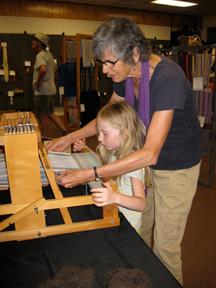
Diana Abrell gives a quick weaving lesson at the 2014 Nevada County Fair
Even so, we still enjoy getting our hands dirty. Closer to the barns, the guild sets up “AgSperience” for a hands-on, color rich “fleece to yarn” education. Visitors may touch raw fleece, look at the dyes, read the story boards, and watch as spinners turn goat and sheep roving into yarn. In some years this has been the venue for a complete sheep-to-shawl event. Part of our public and educational outreach, spinners and weavers demonstrate in both the Wool Room and AgSperience. Some looms are set up for visitors to try out, with children receiving special encouragement.
At present we have only one formal study group, the Backstrap Weavers; however, we have several opportunities to get together and exchange ideas. Once a month, we bring our spinning wheels and portable handwork to “Social Saturday,” a time to visit or just quietly work in a circle of friends. Spontaneous “Knit Nights” are announced via email. During the warm months, we have a booth at the Grower’s Market, primarily for demonstration and public interaction. In the summer, our annual “Dye Day” gives members a chance to learn the art of dyeing and to color fiber to their heart’s content. In the fall, many demonstrate spinning at the local Celtic Festival.
Some of our more experienced members have offered classes in knitting, spinning, weaving and basketry. These classes become the occasion to learn from each other. While not guild sponsored, the guild acts as the contact point, helping teachers and students find each other. Through the diligence and generosity of a few members, we have also been able to bring in talented artisans for guild workshops, even though our out-of-the-way location makes it problematic.
A comparison of the original days of the Foothill Fibers Guild with its present day incarnation needs to take note of the single biggest cultural change that has influenced all our lives: the advent of the computer. Sales, newsletters, and personal communications are mostly handled now via internet. Computers are a new tool for drafting, and – amid controversy—a tool for weaving. So it is apt that Dee Jones concluded her interview by comparing weaving to learning the computer. As she looked back at the early days, she also had a sense of adventure and a willingness to learn which turned her eyes to the future. In her life, she took lots of risks—with people, with her textile work—and she encouraged others to do the same. She spoke of trying new things with weaving and clothes making: “It’s a bit like learning computer. Just try it, push a button. The computer is not going to break—although you may not be able to retrace your steps. One thing is different with weaving – there’s always a string to hold on to to help you find your way back.”

Current Logo June 2015
On June 11, 2015, The Foothill Fibers Guild lost one of its brightest ribbons, Dee Jones. Dee was a founding member, an elder and wise woman, a role model, inspiration and amiable colleague. In a guild that has done a lot of shape shifting over the years, Dee was one sturdy warp thread that never broke. Six weeks before her passing, we briefly interviewed her about the origins of the guild. This article is taken from that conversation and supplemented by early guild newsletters and our two remaining charter members, Lindsey Cleveland and Sue Vogt.